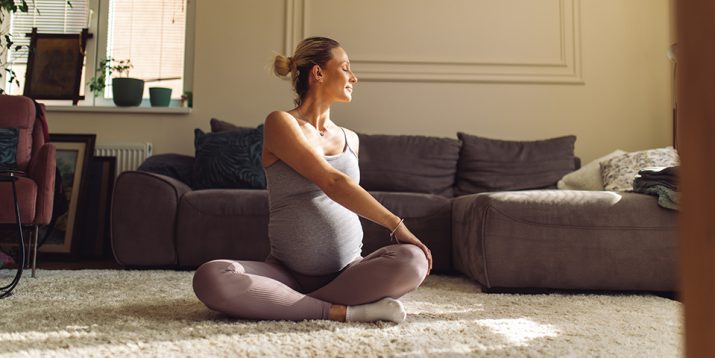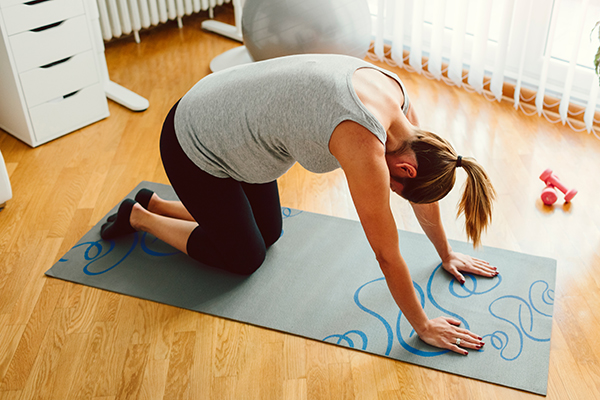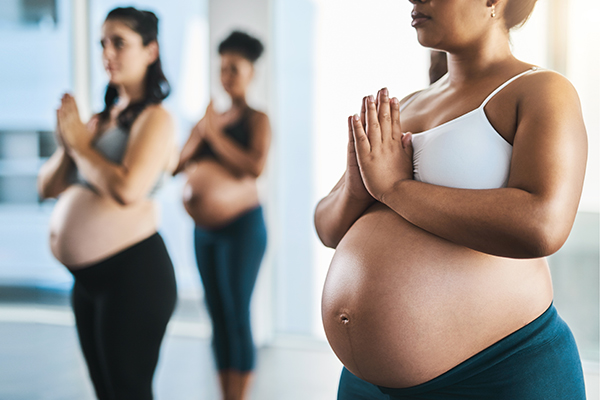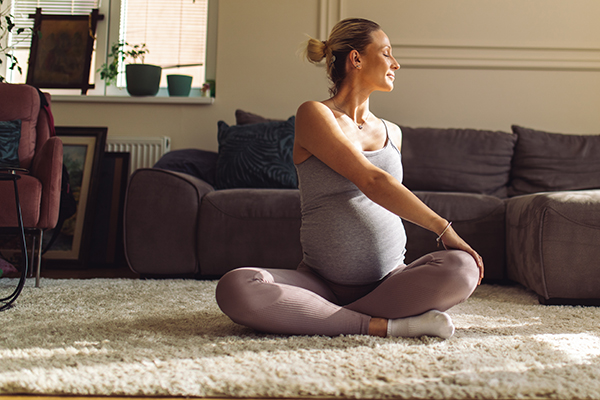Yoga for Pregnancy

Pregnancy is a joyous time, but it is also a time of constant change. Your favorite foods may be off-limits or unappealing, you frequently experience new sensations and emotions, and your body changes quickly — sometimes overnight.
That’s why Emily Silver, a Boston-area nurse practitioner specializing in obstetrics and gynecology, recommends yoga during pregnancy.
Prenatal yoga lets moms multitask, by providing stress relief, self-care, and exercise.
During pregnancy, yoga offers a mind-body connection that helps you focus on the moment and provides a sense of calm amid so much change and growth.
What Are the Benefits of Yoga During Pregnancy?

“There are many potential benefits of yoga during pregnancy,” says Libby Hinsley, a physical therapist, yoga teacher, and yoga therapist based in Asheville, N.C.
“Improved stability, flexibility, breath awareness, and mindfulness practices can help expecting mothers feel better in their bodies, help them better manage some of the common aches and pains that can go along with pregnancy.”
Once cleared by their doctor, pregnant women are encouraged to exercise at least 150 minutes a week at a moderate level, according to the American College of Obstetricians and Gynecologists (ACOG).
The ACOG considers prenatal yoga — along with walking, water workouts, and stationary biking — to be among the safest activities for pregnant women.
A 2012 research review reported that yoga during pregnancy yielded mind-body benefits for mom through labor and delivery, and some of those benefits also extended to the baby.
“The key is finding the right classes,” says Desi Bartlett, who created a pre- and post-natal yoga series for Beachbody (now BODi).

Even though she was a yoga instructor herself, she felt like Goldilocks trying to find yoga that was “just right” when she was pregnant.
“Some were too easy. Others were too hard and never once mentioned the baby,” says Bartlett, a yoga teacher and personal trainer with a master’s degree in corporate fitness. “It was my mission to create practices that would support women throughout pregnancy — and beyond.”
“Many of the positions we practice in yoga are also very good laboring and birthing positions,” says Hinsley.
“Especially for pushing, you need a lot of strength and flexibility and so you’ve done yourself a service by doing yoga,” says Silver, who co-owns Boston NAPS, a private nursing service that offers prenatal education — including yoga.
Bartlett’s program is designed with safe, effective workouts appropriate for each trimester of pregnancy, plus workouts for mom and baby bonding, and core workouts specially designed for new moms.
“A comprehensive prenatal and postnatal yoga program can complement traditional childbirth classes,” says Silver.
While labor and delivery classes instruct women on breathing techniques, yoga programs put those techniques into practice. Her patients see the results during labor, delivery, and recovery.
First Trimester Yoga
During the first trimester, when women may feel symptoms like fatigue or nausea, Silver encourages them to focus on the breath with yoga and meditation as a way to engage the parasympathetic nervous system (aka, “rest-and-digest” mode).
“Yoga increases our state of relaxation,” says Silver, as we learn to adjust to being pregnant.
Bartlett’s “First Trimester Flow” is a comprehensive yoga routine for expectant mothers in their first trimester.
“Teaching your body to practice around the baby is very important, and we can begin that work in the first trimester,” says Bartlett. She encourages women to work with the idea of “celebrating new life” as they take their time and move slowly on the mat.
This practice includes gentle sun salutations, side stretches, and hip openers — plus flows with squats for pelvic floor strength.
Second Trimester Yoga
Many moms feel their energy returning to normal during the second trimester. That’s why “Second Trimester Flow” is a little more energetic, with larger movements like Warrior 2 and Goddess pose.
These poses can build strength in the hips, which need support throughout pregnancy.
“Getting comfortable with squatting and moving around in some of these other positions can really help prepare for labor,” says Hinsley.
Designed to carry you through your second trimester, this calming yet energizing yoga routine will continue to build strength and balance as you head toward your third trimester.
“We train the body for this trimester by making sure that your muscles are strong, flexible, and can support you and baby,” says Bartlett. And she offers plenty of modifications to make room for your growing belly.
Third Trimester Yoga
Bartlett calls the third trimester the home stretch. This isn’t the time to push your body, so “Third Trimester Flow” builds strength and flexibility, but uses a chair for support.
“Mom may want to widen her stance during standing postures to accommodate her expanding pelvis, and to gain stability,” says Hinsley. “She may need extra support such as the wall or a chair for balance postures.” Bartlett offers cues and modifications for both.
“While we still enjoy squats and some of the larger movements that will help us to maintain our strength, these are the days when we need to take it easy,” says Bartlett about yoga performed in the third trimester.
There is a specific reason why a chair is used during third-trimester yoga classes.
During pregnancy, the hormone relaxin is released to relax ligaments in preparation for childbirth. The chair provides support so that you don’t stretch too deep and possibly cause injury.
“By far the biggest precaution for yoga during pregnancy is the risk of injuries due to overstretching,” says Hinsley.
Core Strength after Pregnancy

Just as you slowly eased into yoga during pregnancy, waiting until you had your doctor’s OK, you should do the same after delivery.
During this time, yoga “gives mom a way to get back into some gentle movement to support her body as it continues to transform in the postpartum period,” says Hinsley.
“Postnatal Core” is a yoga routine designed to safely and effectively build core strength after pregnancy.
Bartlett has two sons, so she knows that moms need to be strong and empowered.
Her flow focuses on recovering core strength while lengthening the low back so it feels good and strong in your daily life.
“We forget to take care of ourselves,” says Silver — who has two little ones — so yoga also lets mom focus on herself.
Yoga and Diastasis Recti
Pregnancy can sometimes lead to a condition called diastasis recti, or abdominal separation. When this happens, the connective tissue that holds together the two sides of your rectus abdominis (aka, the “six-pack”) gets a bit overstretched.
This can happen with multiples, large babies, or simply if the mom has a very tight core.
After pregnancy, some women are left with a gap of three fingers or more between the two sides of their abs.
“Most women are never checked for diastasis recti in the postpartum period, and if left untreated, it can lead to further problems down the road, such as low back pain or hip pain,” says Hinsley, who specializes in women’s pelvic health.
In “Workshop: Diastasis Recti 101,” Bartlett walks you through the causes of diastasis recti, how to identify it, and how to approach exercise safely.
Her prenatal programs are designed to help prevent this, training the core through stabilization instead of through forward flexion during pregnancy. Bartlett’s program can help moms regain that core stability and strength safely.
Note: This is a condition that should be confirmed by your doctor.
Mommy & Me Yoga
If you follow Bartlett’s program, your baby will know the effects of yoga before she is even born. The mom-and-baby bonding can continue, with “Mommy & Me” yoga right in your own home.
Designed for babies 6-12 months old, this total-body yoga routine teaches you fun ways to interact with your little one as you practice. You get to work on core strength and squeeze in a workout while playing with your baby.
“It can be hard as a new mom to make time to go to the gym, and then have to pay for childcare,” says Bartlett. “In this session, babies begin to learn about their own kinesthetic awareness (where their body is in space), and of course, they just love the interaction with mommy.”
The Bottom Line
During pregnancy and after delivery, yoga is a safe, effective workout for mom — and it’s safe for baby, too.
